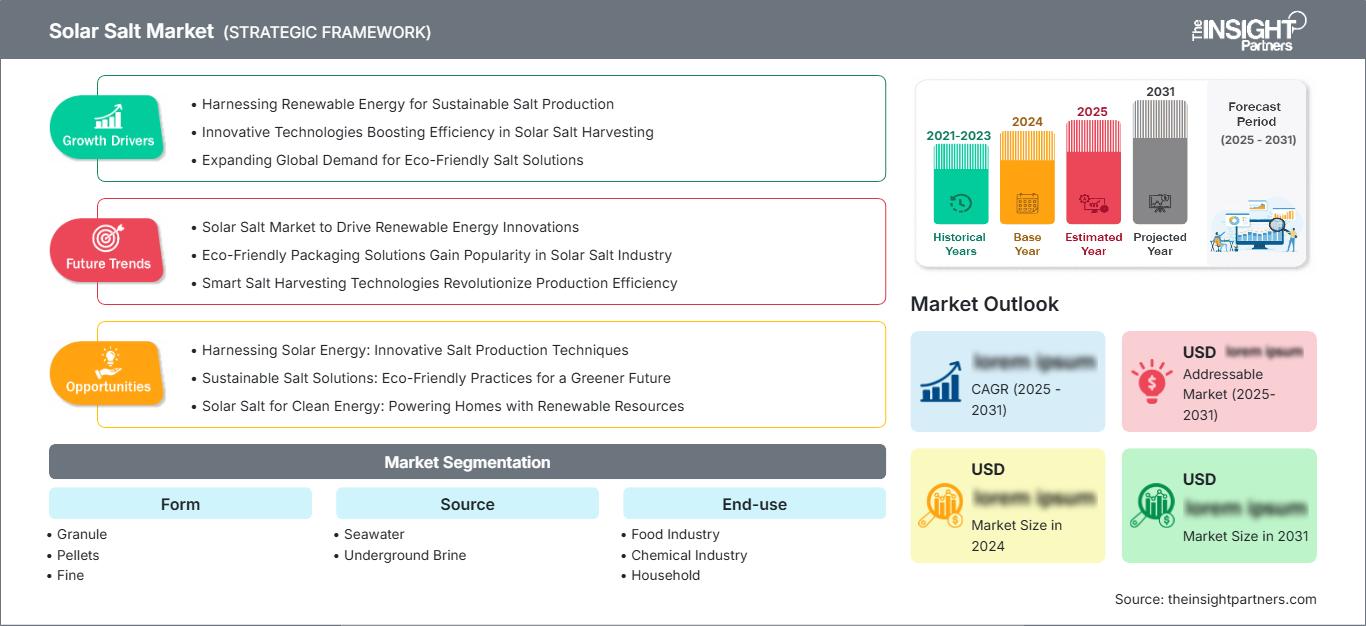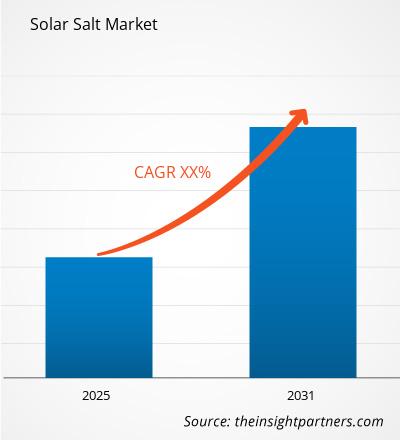Le marché du sel solaire devrait enregistrer un TCAC de XX % entre 2025 et 2031, avec une taille de marché passant de XX millions de dollars américains en 2024 à XX millions de dollars américains d'ici 2031.
Le rapport est classé par forme (granulés, granulés, fines) et analyse plus en détail le marché en fonction de la source (eau de mer, saumure souterraine). Il examine également le marché par utilisation finale (industrie alimentaire, industrie chimique, ménage) et par canal de distribution industriel (entreprise vers consommateurs, entreprise vers consommateurs). Une ventilation complète est fournie aux niveaux mondial, régional et national pour chacun de ces segments clés. Le rapport inclut la taille du marché et les prévisions pour tous les segments, présentées en dollars américains. Il fournit également des statistiques clés sur la situation actuelle du marché des principaux acteurs, ainsi que des informations sur les tendances du marché et les opportunités émergentes.
Objectif du rapport
Le rapport sur le marché du sel solaire de The Insight Partners vise à décrire le paysage actuel et la croissance future, les principaux facteurs moteurs, les défis et les opportunités. Cela fournira des informations à diverses parties prenantes commerciales, telles que :
- Fournisseurs/fabricants de technologie : pour comprendre l’évolution de la dynamique du marché et connaître les opportunités de croissance potentielles, leur permettant de prendre des décisions stratégiques éclairées.
- Investisseurs : pour effectuer une analyse complète des tendances concernant le taux de croissance du marché, les projections financières du marché et les opportunités qui existent tout au long de la chaîne de valeur.
- Organismes de réglementation : pour réglementer les politiques et surveiller les activités du marché dans le but de minimiser les abus, de préserver la confiance des investisseurs et de maintenir l’intégrité et la stabilité du marché.
Formulaire de segmentation du marché du sel solaire
- Granulés
- Granulés
- Fins
Source
- Eau de mer
- Saumure souterraine
Utilisation finale
- Industrie alimentaire
- Industrie chimique
- Ménage
Canal de distribution
- Entreprise vers consommateurs
- Entreprise vers consommateurs
Vous bénéficierez d’une personnalisation sur n’importe quel rapport - gratuitement - y compris des parties de ce rapport, ou une analyse au niveau du pays, un pack de données Excel, ainsi que de profiter d’offres exceptionnelles et de réductions pour les start-ups et les universités
Marché du sel solaire: Perspectives stratégiques

- Obtenez les principales tendances clés du marché de ce rapport.Cet échantillon GRATUIT comprendra une analyse de données, allant des tendances du marché aux estimations et prévisions.
Moteurs de croissance du marché du sel solaire
- Exploiter l'énergie renouvelable pour une production de sel durable
- Technologies innovantes améliorant l'efficacité de la récolte de sel solaire
- Demande mondiale croissante de solutions de sel écologiques
Tendances futures du marché du sel solaire
- Le marché du sel solaire stimulera les innovations en matière d'énergie renouvelable
- Les solutions d'emballage écologiques gagnent en popularité dans l'industrie du sel solaire
- Les technologies intelligentes de récolte de sel révolutionnent l'efficacité de la production
Opportunités du marché du sel solaire
- Exploiter l'énergie solaire : techniques innovantes de production de sel
- Solutions de sel durables : pratiques écologiques pour un avenir plus vert
- Le sel solaire pour une énergie propre : alimenter les foyers en énergie renouvelable Ressources
Marché du sel solaire
Les tendances régionales et les facteurs influençant le marché du sel solaire tout au long de la période de prévision ont été analysés en détail par les analystes de The Insight Partners. Cette section aborde également les segments et la géographie du marché du sel solaire en Amérique du Nord, en Europe, en Asie-Pacifique, au Moyen-Orient et en Afrique, ainsi qu'en Amérique du Sud et en Amérique centrale.
Portée du rapport sur le marché du sel solaire| Attribut de rapport | Détails |
|---|---|
| Taille du marché en 2024 | US$ XX Million |
| Taille du marché par 2031 | US$ XX Million |
| TCAC mondial (2025 - 2031) | XX% |
| Données historiques | 2021-2023 |
| Période de prévision | 2025-2031 |
| Segments couverts |
By Forme
|
| Régions et pays couverts | Amérique du Nord
|
| Leaders du marché et profils d'entreprises clés |
|
Densité des acteurs du marché du sel solaire : comprendre son impact sur la dynamique des entreprises
Le marché du sel solaire connaît une croissance rapide, portée par une demande croissante des utilisateurs finaux, due à des facteurs tels que l'évolution des préférences des consommateurs, les avancées technologiques et une meilleure connaissance des avantages du produit. Face à cette demande croissante, les entreprises élargissent leur offre, innovent pour répondre aux besoins des consommateurs et capitalisent sur les nouvelles tendances, ce qui alimente la croissance du marché.
- Obtenez le Marché du sel solaire Aperçu des principaux acteurs clés
Principaux arguments de vente
- Couverture exhaustive : Le rapport couvre l’analyse exhaustive des produits, services, types et utilisateurs finaux du marché du sel solaire, offrant un panorama global.
- Analyse d’experts : Le rapport est élaboré à partir d’une compréhension approfondie des experts et analystes du secteur.
- Informations actualisées : Le rapport garantit la pertinence commerciale grâce à sa couverture des informations récentes et des tendances des données.
- Options de personnalisation : Ce rapport peut être personnalisé pour répondre aux besoins spécifiques des clients et s’adapter aux stratégies commerciales.
Le rapport de recherche sur le marché du sel solaire peut donc contribuer à la compréhension du marché et des perspectives de croissance. Malgré quelques préoccupations légitimes, les avantages globaux de ce rapport tendent à l’emporter sur les inconvénients.
- Analyse historique (2 ans), année de base, prévision (7 ans) avec TCAC
- Analyse PEST et SWOT
- Taille du marché Valeur / Volume - Mondial, Régional, Pays
- Industrie et paysage concurrentiel
- Ensemble de données Excel
Rapports récents
Rapports connexes
Témoignages
Raison d'acheter
- Prise de décision éclairée
- Compréhension de la dynamique du marché
- Analyse concurrentielle
- Connaissances clients
- Prévisions de marché
- Atténuation des risques
- Planification stratégique
- Justification des investissements
- Identification des marchés émergents
- Amélioration des stratégies marketing
- Amélioration de l'efficacité opérationnelle
- Alignement sur les tendances réglementaires




















 Obtenez un échantillon gratuit pour - Marché du sel solaire
Obtenez un échantillon gratuit pour - Marché du sel solaire